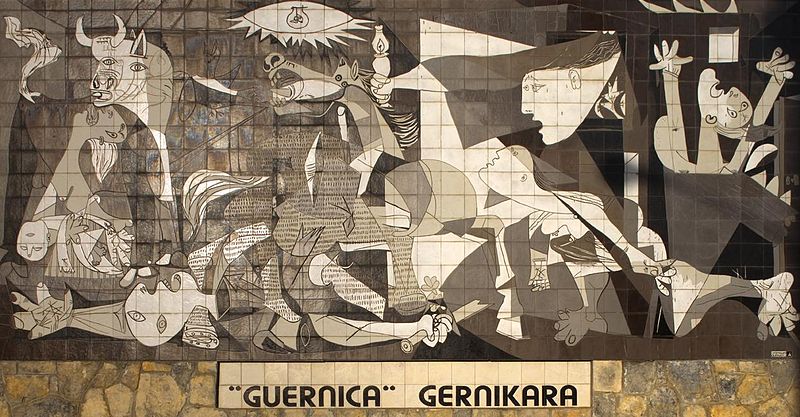Guernica 1937. Picasso.
In the 1930s,, Franco in Spain was waging war against Spanish civilians. With help from Hitler, he chose to bomb the Basque town of Guernica. To quote Picasso ‘ The war in Spain is the battle of reaction against the people, against liberty.’
Picasso had a horror of the military caste, which plunged Spain into a sea of suffering and death. He was making a political stand when he worked on Guernica. He portrayed a mirror-image of a world of atrocity and bestiality – ‘ from which it is man’s duty to emerge.’
The symbols he uses are powerful, the noble horse is struck down, the bull represents a brutal force of darkness. Faces were distorted with pain, light comes from an electric light bulb, not the sun, there is no divine power to relieve them. As work progressed, photographs were taken of each stage, to reveal Picasso’s thinking processes.
In order to understand Picasso, it helps to ‘grasp his idea and hold it.’ It is an historical painting, painted to remember their own history. We are asked to accept Picasso’s idea and images, or we cannot understand his work.
Picasso was aware of the poem by Eluard,
La Victoire de Guernica. 1936:-
Watch the builders at work
They are rich, patient, disciplined, black and stupid
But they do their best to be the only ones on earth
They are on the edges of humanity and heap it over with ordure
They flatten mindless palaces to ground level.
I think of Ground Zero.
Picasso also wrote a poem called The Dream and Lie of Franco.


Hi Norma
I lived in Bilbao for many years, which is just down the road from Gernika (as the Basques call it) and I visited the town on many occasions. During my time living in the Basque Country, I often heard how Gernika was bombed on market day, arguably to cause the maximum civilian casualties and that it was the first real trial of “blitzkrieg” by the Luftwaffe etc. However, it was only actually seeing the painting a few years ago in the the Reina Sofia Art Gallery in Madrid that it really hit home what had happened that day. The sheer size of the painting blew me away (it’s about 8 metres long) and it somehow managed to give a sense of the enormity of what had occurred.
Hi Barry,
I would have liked to stand in front of the original painting of Gernika, in order to experience its full power as you did. One of the symbols he used, the bull, echoed his Spanish roots, he wasn’t averse to going to a bull fight, on the other hand, he also painted the dove of peace. He sometimes used themes from the ancient world, where bulls were metaphorical symbols of power, The Orgy of the Minotaur 1933, is an example, it features a bull.